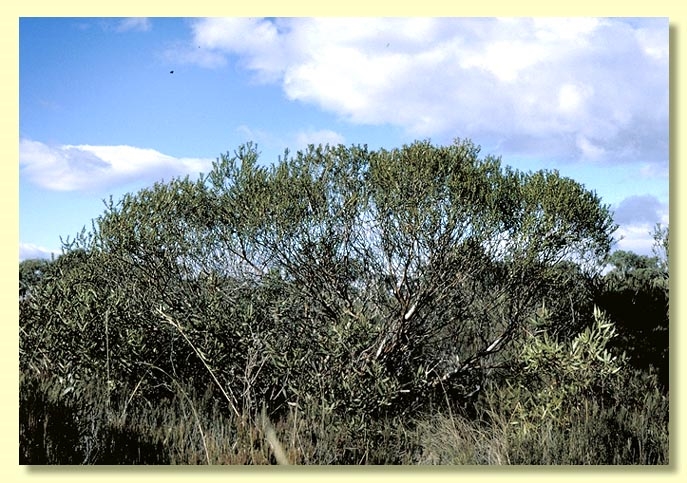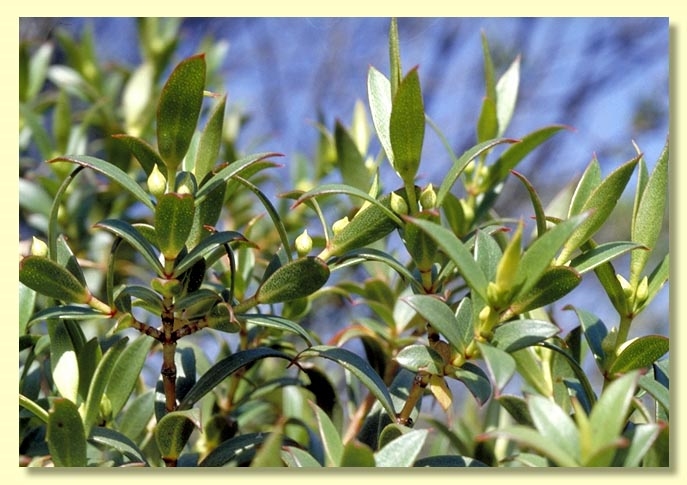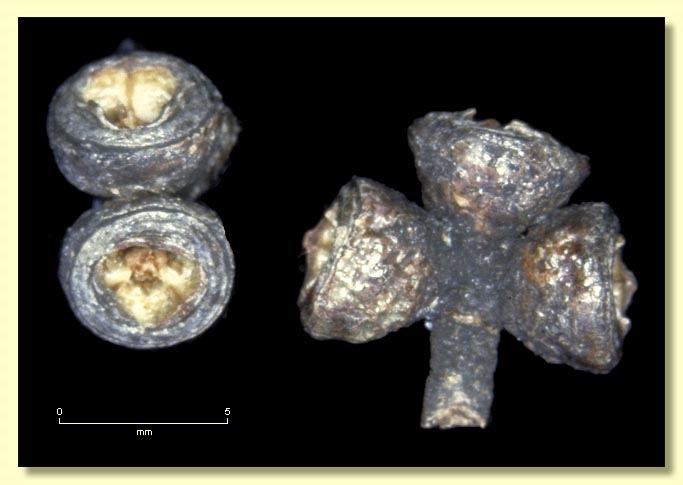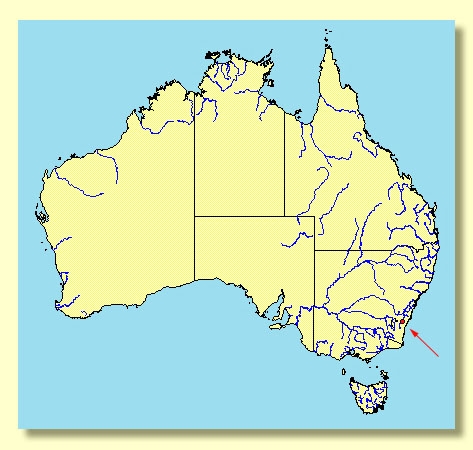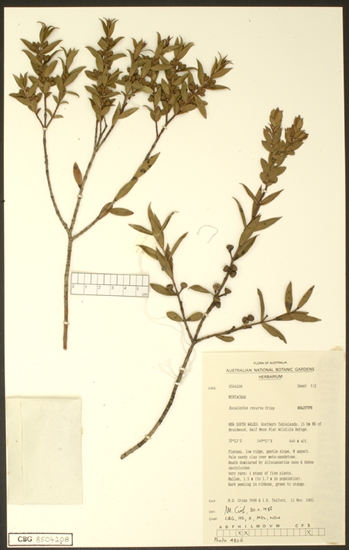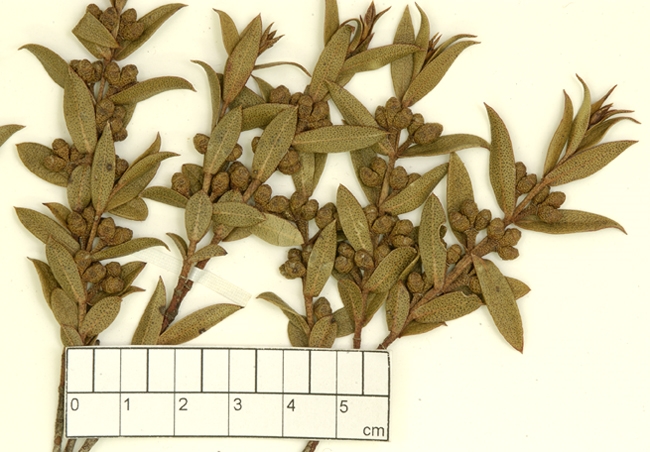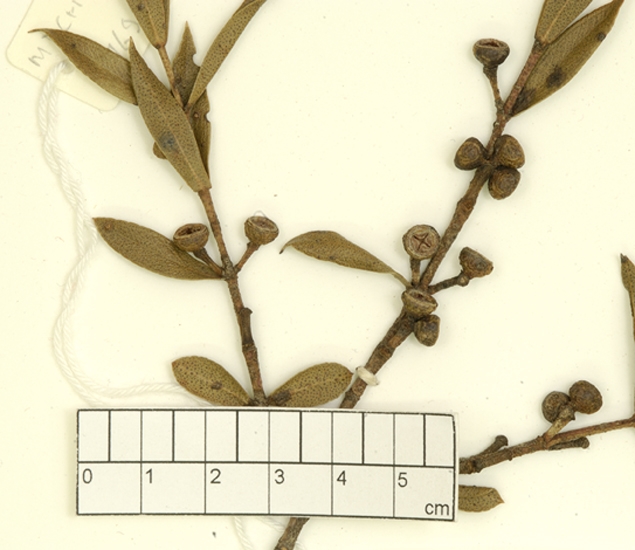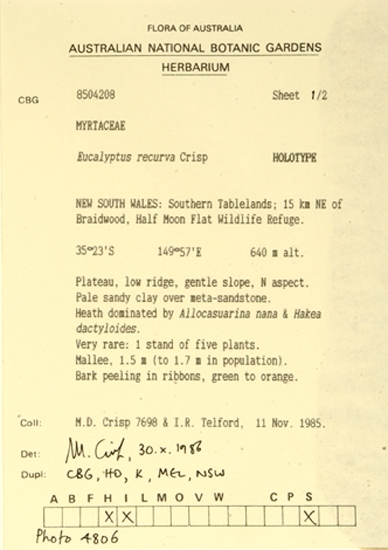Euclid - Online edition
Eucalyptus recurva
Eucalyptus | Symphyomyrtus | Maidenaria | Obscurae
T: New South Wales: NE of Braidwood, 11 Nov. 1985, M.D.Crisp 7698 & I.R.Telford: holo: CANB ; iso: HO, K, MEL, NSW.
Bark smooth, grey, green, brown, white, cream and orange, at times with ribbons of decorticated bark in the branches.
Juvenile growth (coppice or field seedlings to 50 cm): stems round in cross-section; juvenile leaves always opposite and sessile, crowded on stems, elliptical to obovate or ovate, 1–2 cm long, 0.4–0.8 cm wide, base tapering, surface distinctly glandular, green.
Crown consisting of juvenile leaves; on flowering branchlets the leaves to 3.2 cm long and 0.4–0.8 cm wide, conspicuously recurved in distal half, discolorous, dull to slightly glossy, green, side-veins greater than 45° to midrib, reticulation invisible, intramarginal vein parallel to and just within margin, oil glands island.
Inflorescence axillary unbranched, peduncles 0.3–0.5 cm long, buds 3 per umbel; buds sessile or on 0.1 cm pedicels. Mature buds broadly ovoid and rugose, 0.4–0.5 cm long, 0.3–0.4 cm wide, scar present (outer operculum shed midway through bud dvelopment), operculum rounded (pointed when immature), stamens inflexed, anthers cuboid to oblong, versatile, dorsifixed, dehiscing by longitudinal slits (non-confluent), style short, stigma blunt, locules 3 or 4, the placentae each with 4 vertical ovule rows. Flowers white.
Fruit sessile, hemispherical, 0.3 cm long, 0.4–0.6 cm wide, disc level or descending, valves 3 or 4, near rim level.
Seeds brown, 0.8–1.3 mm long, ovoid or flattened-ovoid, dorsal surface smooth or shallowly pitted, hilum ventral.
Cultivated seedlings (measured at ca node 10): cotyledons bilobed to oblong; stems square in cross-section; leaves sessile and opposite for many nodes, ovate, 0.4–2.1 cm long, 0.4–0.8 cm wide, base tapering, margin entire, apex rounded, dull, green.
Flowering has been recorded in January.
A dense mallee shrub known from only three plants north-west of Mongarlowe on the Southern Tablelands of New South Wales, on quartzite. E. recurva could not be confused with any other species because of the very small leaves, recurved at the tip.
E. recurva is morphologically closest to E. parvula, also a species confined to of the Southern Tablelands north-east of Cooma. E. parvula differs in being a small tree with larger leaves and seven-budded inflorescences (usually three-budded in E. recurva). Both E. recurva and E. parvula do not seem to be highly self-fertile or inter-fertile with other members of the same species and seed of both species are often hybrids with various compatible local species. Seedlings raised from E. recurva show considerable variation in juvenile leaf shape suggesting hybridisation with nearby species, probably with E. aggregata and E. mannifera.
Eucalyptus recurva belongs in Eucalyptus subgenus Symphyomyrtus section Maidenaria, a large group of species more or less restricted to south-eastern Australia, characterised by bilobed cotyledons, simple axillary inflorescences, buds with two opercula, stamens with versatile anthers and flattened seeds with a ventral hilum. Within this section, E. recurva, with E. parvula, forms the small subsection Obscurae, having smooth bark, a crown of opposite juvenile leaves, small buds, a short style and small flat-topped fruit.
Eucalyptus recurva is listed as "Endangered" under the Australian Government Environment Protection and Biodiversity Conservation Act 1999 (EPBC Act). Further information may be found at this web address:
http://www.environment.gov.au/cgi-bin/sprat/public/sprat.pl

